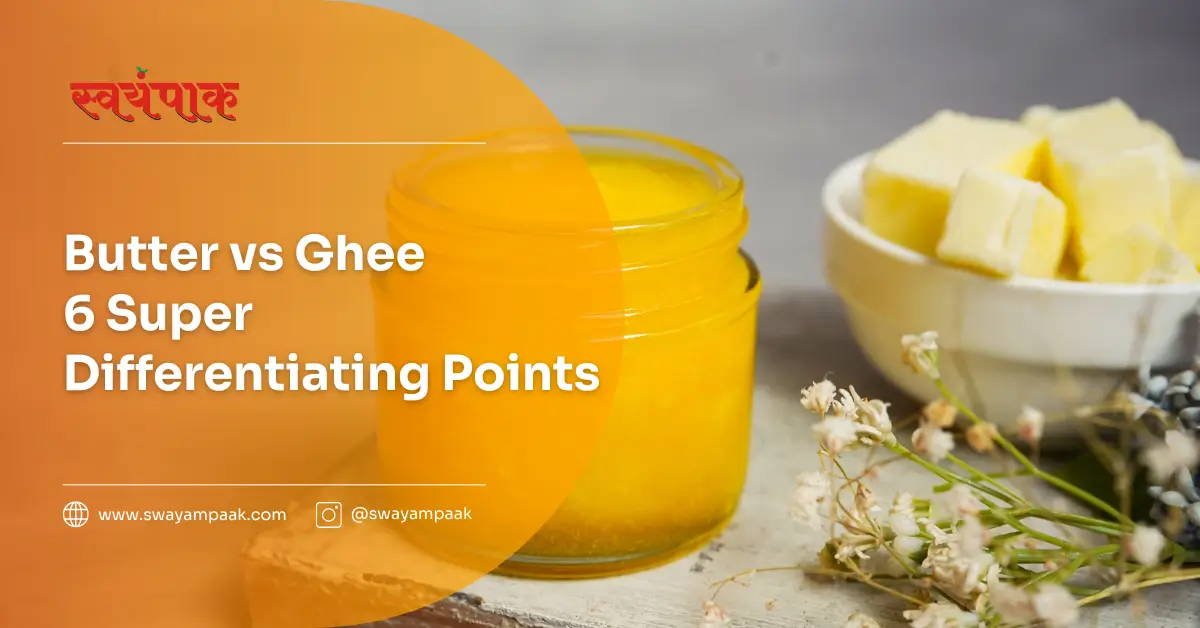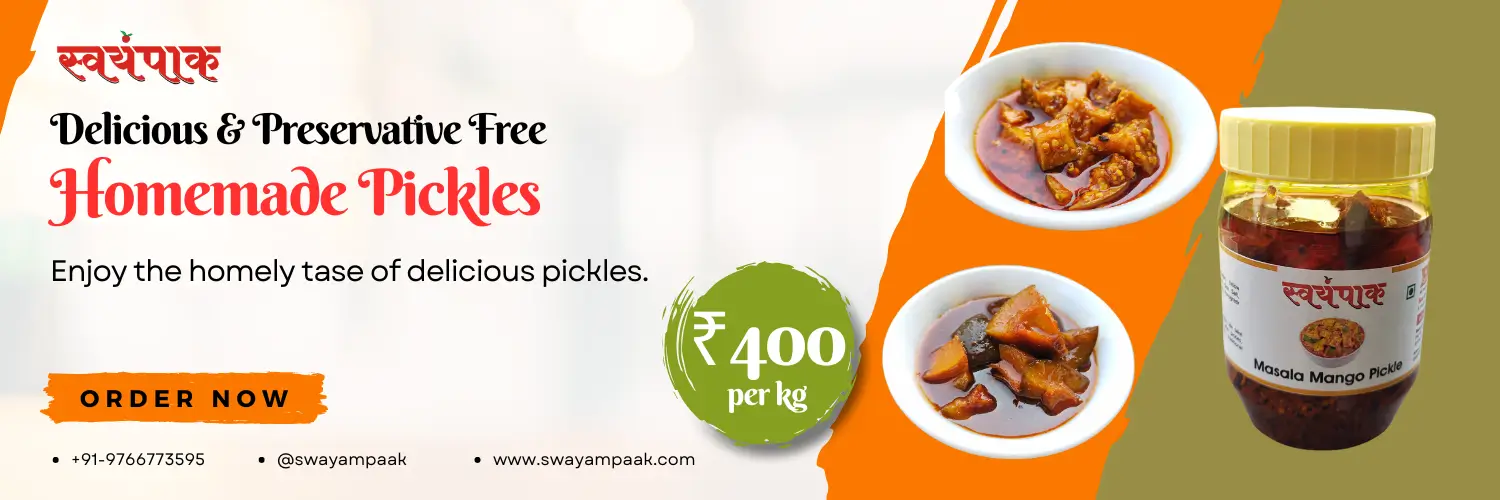Did you know that butter was discovered over 4,000 years ago by accident when milk was transported in skin bags on horseback? Both butter and ghee have storied histories and distinct roles in culinary traditions around the world. While butter is a staple in Western kitchens, ghee holds a place of honour in South Asian cuisine.
In this article Butter vs ghee, Let’s dive into the world of butter and ghee to uncover their differences and decide which one suits your needs best.
7 key takeaways from the blog post “Butter vs Ghee”:
- Butter and ghee are both dairy products with distinct origins and uses. Butter is a staple in Western cuisine, while ghee holds a special place in South Asian cuisine.
- Butter is made by churning cream, separating fat (butterfat) from liquid (buttermilk). It contains water, milk solids (lactose and casein), and fat. There are salted, unsalted, and cultured butter varieties.
- Ghee is clarified butter made by simmering butter to remove water and milk solids. This process results in a higher fat concentration, richer flavour, and higher smoke point compared to butter. Ghee has variations in colour and flavour depending on the caramelization level.
- Ghee is generally lactose-free and casein-free due to the removal of milk solids during clarification, making it suitable for people with lactose intolerance. Butter contains lactose and casein.
- Ghee has a higher smoke point than butter, making it ideal for high-heat cooking methods like stir-frying and sautéing. Butter burns more easily at high temperatures.
- Butter is higher in Vitamins A and E compared to ghee due to the removal of water and milk solids during clarification. Both contain trace amounts of other vitamins and minerals.
- The choice between butter and ghee depends on your needs. Butter is better for baking and spreading due to its moisture content. Ghee is the champion for high-heat cooking and adds a deeper flavour to dishes. Experiment with both to discover their culinary potential.
Breaking Down the Basics: Butter vs Ghee
| Property | Butter | Ghee |
|---|---|---|
| Composition | Water, milk solids, and butterfat | Mostly butterfat, minimal water and milk solids |
| Flavor | Rich, creamy, slightly sweet | Rich, nutty, caramel-like |
| Smoke Point | Around 150-175°C (302-347°F) | Around 250°C (482°F) |
| Shelf Life | Short, needs refrigeration | Long, can be stored at room temperature |
| Lactose Content | Contains lactose | Almost no lactose (clarified butter) |
| Cooking Use | Baking, sautéing, spreading | High-heat cooking, deep-frying, sautéing |
| Nutritional Value | Contains vitamins A, D, E, K; cholesterol | Contains vitamins A, D, E, K; higher in butyrate and CLA |
| Production Process | Churning cream, then solidifying | Clarifying butter by simmering and removing milk solids |
| Dietary Considerations | May not be suitable for lactose intolerant individuals | Suitable for most lactose intolerant individuals |
| Traditional Use | Common in Western cuisine | Common in Indian and Middle Eastern cuisine |
Butter
Butter is a dairy staple made by churning cream until it separates into two distinct components: butterfat, the creamy solid we love, and buttermilk, a tangy leftover liquid. This churning process concentrates the fat content, resulting in a rich spread that elevates countless dishes.
Unveiling Butter’s Composition: Beyond the delightful fat, butter also contains water and milk solids, like lactose (milk sugar) and casein (a milk protein). These components contribute to butter’s texture and flavour profile.
A World of Buttery Options: The world of butter extends beyond the classic unsalted stick. Salted butter adds a touch of savoury goodness, while unsalted butter provides more versatility for baking and allows for customized seasoning. Cultured butter, made from fermented cream, boasts a slightly tangy flavour that complements certain dishes beautifully.
Ghee
Ghee, the star of South Asian cuisine, takes butter to a whole new level. Unlike its creamy cousin, ghee is clarified butter, boasting a richer flavour and higher smoke point. This transformation happens through a simmering process that removes two key elements: water and milk solids.
The Art of Clarification: Traditionally, ghee is made by gently heating butter until the water evaporates. As this happens, the milk solids sink to the bottom and caramelize, adding a nutty depth of flavour. The final step involves straining the golden liquid, leaving behind pure, clarified butterfat – ghee!
Shades of Ghee: Not all ghee is created equal. The length of the simmering process determines the colour and flavour. White ghee undergoes minimal browning, resulting in a subtler taste. On the other hand, browned ghee simmers for a longer duration, creating a deeper golden colour and a more pronounced, nutty flavour profile.
Nutritional Showdown: Butter vs Ghee
When it comes to fat content, both butter and ghee pack a punch. However, ghee emerges the champion in terms of concentration.
During the clarification process, water and milk solids are removed, leaving behind a higher percentage of pure fat in ghee compared to butter. This translates to a higher calorie count per serving for ghee.
For those with lactose woes, ghee offers a ray of hope. The removal of milk solids during clarification means ghee is generally considered lactose-free and casein-free, unlike butter which contains both. This makes ghee a suitable substitute for butter in recipes for people with lactose intolerance or dairy sensitivities.
Smoke point – that magic temperature where fat starts to break down and smoke fills the air – is another key differentiator. Ghee boasts a significantly higher smoke point (around 485°F or 250°C) compared to butter (around 350°F or 175°C).
This makes ghee the clear winner for high-heat cooking methods like frying and sautéing. Since butter burns more easily at high temperatures, it can impart a bitter flavour to your dish. So, for those sizzling stir-fries or perfectly pan-seared scallops, ghee reigns supreme.
Vitamin and Mineral Variations
While both butter and ghee are primarily fat sources, they do contain some vitamins and minerals. Butter takes the lead when it comes to Vitamins A and E. These fat-soluble vitamins are present in higher quantities in butter due to the removal of water and milk solids during ghee production. However, ghee doesn’t lose them entirely – it just holds onto a smaller amount.
Both butter and ghee also contain trace amounts of other vitamins and minerals, like Vitamin K2 and Vitamin D in butter, and some conjugated linoleic acid (CLA) in ghee. These additional micronutrients contribute to the overall nutritional profiles of these two fats. It’s important to remember that a balanced diet is key, and neither butter nor ghee should be considered a sole source of vitamins and minerals.
Culinary Considerations: A Taste and Texture Showdown
Butter and ghee, though related, offer distinct taste and textural experiences in the kitchen. Butter, the classic spread, boasts a smooth, creamy texture and a familiar, rich yet mild flavour. This makes it a versatile favourite for everything from slathering on toast to enriching pastries and sauces.
Ghee, on the other hand, takes things a step further. The clarification process not only removes water and milk solids but also caramelizes them slightly. This results in a unique nutty aroma and a deeper, more complex flavour profile compared to butter. Ghee’s texture remains relatively similar to butter, offering a clarified richness that shines in South Asian cuisine and adds depth to various dishes.
Culinary Considerations: Butter vs Ghee
Knowing when to use butter and when to reach for ghee can elevate your cooking game. Here’s a breakdown of their strengths:
- Butter: The Baking Champion – Butter’s magic lies in its moisture content. This makes it ideal for baking, creating fluffy cakes, flaky pastries, and tender cookies. Its creamy texture also enhances sauces and adds richness to mashed potatoes. However, due to its lower smoke point, butter is best suited for low to medium-heat cooking applications.
- Ghee: The High-Heat Hero – Ghee’s high smoke point makes it the undisputed king of high-heat cooking. It shines in stir-fries, pan-frying, and roasting, where it can withstand the heat without burning and imparting a bitter flavour. The nutty aroma and deeper taste of ghee also add a unique dimension to curries, sautéed vegetables, and Indian flatbreads.
Striking a Healthy Balance: Butter vs Ghee
The delicious world of butter and ghee comes with a side of health considerations. Both contain saturated fat, a subject of ongoing debate regarding its impact on heart health. Here’s the key difference: ghee, due to the removal of water and milk solids, boasts a higher concentration of fat per serving, and consequently, more saturated fat compared to butter.
Moderation is key. Enjoy these flavorful fats in controlled portions, remembering that individual dietary needs and health conditions can influence what’s best for you. Consulting a healthcare professional can provide personalized advice on incorporating butter and ghee into your diet, ensuring a delicious and balanced approach to your culinary journey. After all, a healthy you is a happy cook!
Conclusion: Choosing Your Culinary Champion
Butter and ghee, though related, offer distinct paths to elevate your cooking. Butter reigns supreme in the world of baking, its moisture content creating fluffy pastries and rich sauces. Its creamy texture makes it a beloved spread, too. However, its lower smoke point limits its use in high-heat applications.
Ghee, the clarified butter champion, takes the spotlight when heat is involved. Its high smoke point makes it perfect for stir-fries, pan-frying, and roasting, where it adds a unique nutty flavour without burning. Ghee’s depth of taste also shines in curries and sautéed vegetables.
The choice between butter and ghee ultimately depends on your needs. If baking and spreading are your priorities, butter is your friend. For high-heat cooking and a deeper flavour profile, ghee is the hero. The best part? You can experiment with both! So, explore the culinary possibilities and discover how butter and ghee can transform your dishes.
FAQs:
Is ghee better for you than butter?
Ghee is a natural food with a long history of medicinal and culinary uses. It provides certain cooking advantages over butter and is certainly preferable if you have a dairy intolerance. Both can be enjoyed in moderation as part of a healthy diet. However, no evidence suggests that it’s healthier than butter overall.
Can we replace ghee with butter?
I wouldn’t recommend replacing ghee with butter as their properties are very different. Butter contains a lot of moisture, while ghee is concentrated fat. It is so because ghee is made after churning butter and hence, contains no moisture.
What is the difference between ghee and shea butter?
Shea butter is an oil from a nut used in cosmetics. Ghee is clarified butter used for cooking. So which is best depends on what you want to do with it.
What is the difference between ghee and clarified butter?
Use clarified butter for frying and sautéing — it is excellent for cooking eggs, popping popcorn or cooking steak. Clarified butter also makes a mean hollandaise. Ghee is clarified butter cooked further to nutty golden perfection. It’s basically an extreme version of clarified butter with a shelf life like uranium


